Yay! The ducks are back!
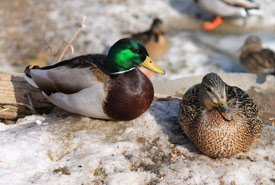
Mallards — male on the left, female on the right. (Photo by Pia Vahabi/NCC staff)
Here in Toronto, winter and waterfowl don’t necessarily sound like two things that should go together. But the truth is, while some birds (and people) escape Ontario’s cold winter to warmer climes, others migrate from the Arctic to spend their winters “down south” in the Great Lakes region.
With the seasons once again changing, I can’t help but wonder where in the world the birds I’m now starting to see have travelled from. With up to 70 per cent of all North American waterfowl breeding in Canada, it is not surprising that most of the waterfowl we see are migratory. The conservation of shorelines and wetlands is crucial for these species, ensuring that these seasonal migrants have a place to come year after year.
At a waterfowl birding event, I surprised myself by being able to recognize more than just the Canada geese and mallards. Waterfowl are great for beginner birders like me because wherever there is water, there are usually waterfowl. And unlike songbirds, they tend to stay still for long enough for me to identify at least one male in breeding plumage. The entire Greater Toronto Area/Lake Ontario waterfront is an incredible duck spectacle all winter, with tens of thousands of long-tailed ducks, mergansers and several scoter species and goldeneyes, in some cases hanging out within metres of the shoreline.
The first five species I learned to identify are some of the more common waterfowl species in southern Ontario (and beyond):
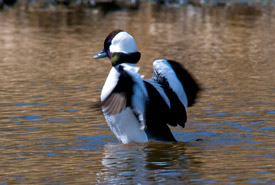
Bufflehead duck (Photo by Karol Dabbs)
1. Bufflehead – Easily distinguished by the male’s bright white head and belly, buffleheads are North America’s smallest diving duck. Because of their size, buffleheads are able to use old northern flicker nests that larger ducks cannot fit into.
2. Mallard – The one bird just about everyone knows. Often overlooked because it is so common, it is actually one of my favourites. Though they can be seen in the Toronto area throughout the year, mallards are moving into more habitat now that the ice is melting and there is more open water with the onset of spring. I’ve even spotted mallards return to the ravine behind our house!
3. Red-breasted merganser – I have to admit that I’m a fan of the red-breasted merganser purely because of its amazing hairdo. These birds can be tricky to distinguish from the common merganser, which looks very similar and can be seen at this time of year. Novice birders are probably best off focusing on males and paying close attention to colouring.
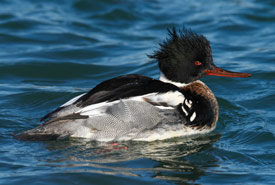
Red-breasted merganser (Photo by Paul Tessier)
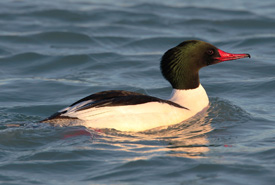
Male common merganser (Photo by Wikimedia Commons)
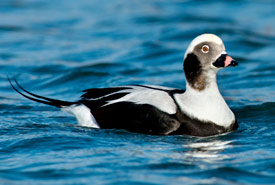
Long-tailed duck (Photo by Paul Reeves)
4. Long-tailed duck – These slick-looking birds breed on the Arctic tundra of northern Canada, Alaska, Europe and Russia. In North America, they come down in large flocks to winter in the Great Lakes region and northeastern seaboard. They will soon be making their way back up north.
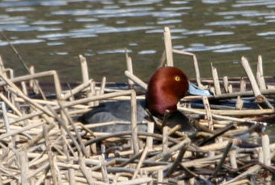
Redhead (Photo by Donna Dewhurst, USFWS)
5. Redhead – I love birds that have logical names (think blue jay, red-winged blackbird, ring-billed gull). It makes life so much easier. The redhead duck is, unsurprisingly, distinguished by the male’s red head (though females are all brown).
The shorelines of southern Ontario is quite the destination for birders and photographers, and people just wanting to admire the waterfowl in their gorgeous winter plumage. By January to March, spectators are treated to the birds' delightful spring plumage.


